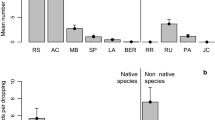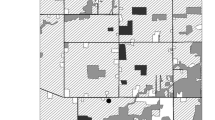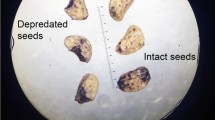Abstract
The incorporation of an animal-dispersed exotic plant species into the diet of native frugivores can be an important step to that species becoming invasive. We investigated bird dispersal of Lonicera maackii, an Asian shrub invasive in eastern North America. We (i) determined which species of birds disperse viable L. maackii seeds, (ii) tested the effect of gut passage on L. maackii seeds, and (iii) projected the seed shadow based on habitat use by a major disperser. We found that four native and one exotic bird species dispersed viable L. maackii seeds. Gut passage through American robins did not inhibit germination, but gut passage through cedar waxwings did. American robins moved mostly along woodlot edges and fencerows, leading us to project that most viable seeds would be defecated in such habitats, which are very suitable for L. maackii. We conclude that L. maackii has been successfully incorporated into the diets of native and exotic birds and that American robins preferentially disperse seeds to suitable habitat.
Similar content being viewed by others
Abbreviations
- AMRO:
-
American robin
- CEWA:
-
Cedar waxwing
References
Bartuszevige AM (2004) The Influence of Habitat Suitability, Landscape Structure and Seed Dispersers on the Invasion of an Exotic Plant Species, Lonicera maackii (Rupr), Herder, Amur Honeysuckle. Ph.D. dissertation, Miami University, Oxford, Ohio
Cipollini ML and Levey DJ (1997). Secondary metabolites of fleshy vertebrate-dispersed fruits: adaptive hypotheses and implications for seed dispersal. American Naturalist 150: 346–372
Clergeau P (1992). The effect of birds on seed-germination of fleshy-fruited plants in temperate farmland. Acta Oecologica 13: 679–686
Collier MH, Vankat JL and Hughes MR (2002). Diminished plant richness and abundance below Lonicera maackii, an invasive shrub. American Midland Naturalist 147: 60–71
Crossland DR and Vander Kloet SP (1996). Berry consumption by the American Robin, Turdus migratorius and subsequent effect on seed germination, plant vigor, and dispersal of the lowbush blueberry, Vaccinium angustifolium. Canadian Field-Naturalist 110: 303–309
Cypher BL and Cypher EA (1999). Germination rates of tree seeds ingested by Coyotes and Raccoons. American Midland Naturalist 142: 71–76
Denslow JS, Levey DJ, Moermond TC and Wentworth BC (1987). A synthetic diet for fruit-eating birds. Wilson Bulletin 99: 131–135
Gorchov DL and Trisel DE (2003). Competitive effects of the invasive shrub, Lonicera maackii (Rupr.) Herder (Caprifoliaceae), on the growth and survival of native tree seedlings. Plant Ecology 166: 13–24
Gould AMA and Gorchov DL (2000). Effects of the exotic invasive shrub Lonicera maackii on the survival and fecundity of three species of native annuals. American Midland Naturalist 144: 36–50
Grabe DF (ed) (1970) Tetrazolium Testing Handbook for Agricultural Seeds. Association of Official Seed Analysts.
Haas CA (1995). Dispersal and use of corridors by birds in wooded patches on an agricultural landscape. Conservation Biology 9: 845–854
Halls LK (ed) (1984) White-tailed Deer: Ecology and Management. Stackpole Books, Harrisburg, Pa. pp. 870
Herrera CM (1985). Determinants of plant–animal coevolution – the case of mutualistic dispersal of seeds by vertebrates. Oikos 44: 132–141
Hidayati SN, Baskin JM and Baskin CC (2000). Dormancy-breaking and germination requirements of seeds of four Lonicera species (Caprifoliaceae) with underdeveloped spatulate embryos. Seed Science Research 10: 459–469
Hoppes WG (1988). Seedfall pattern of several species of bird-dispersed plants in an Illinois woodland. Ecology 69: 320–329
Howe HF and Smallwood J (1982). Ecology of seed dispersal. Annual Review of Ecology and Systematics 13: 201–228
Howe HF and Westley LC (1997). Ecology of pollination and seed dispersal. In: Crawley, MJ (eds) Plant Ecology, Blackwell Science, Cambridge 262–283
Hutchinson TF and Vankat JL (1997). Invasibility and effects of Amur Honeysuckle in southwestern Ohio forests. Conservation Biology 11: 1117–1124
Ingold JL and Craycraft MJ (1983). Avian frugivory on honeysuckle (Lonicera) in southwestern Ohio in fall. Ohio Journal of Science 83: 256–258
Izhaki I, Walton PB and Safriel UN (1991). Seed shadows generated by frugivorous birds in an eastern Mediterranean scrub. Journal of Ecology 79: 676–590
Johnson WC and Adkisson CS (1985). Dispersal of beech nuts by Blue Jays in fragmented landscapes. American Midland Naturalist 113: 319–324
Jordano P (1995). Angiosperm fleshy fruits and seed dispersers: a comparative analysis of adaptation and constraints in plant-animal interactions. American Naturalist 145: 163–191
La Rue CT (1994). Birds of northern Black Mesa, Navajo County, Arizona. Great Basin Naturalist 54: 1–32
Luken JO and Goessling N (1995). Seedling distribution and potential persistence of the exotic shrub Lonicera maackii in fragmented forests. American Midland Naturalist 133: 124–130
Luken JO and Thieret JW (1995). Amur Honeysuckle (Lonicera maackii; Caprifoliaceae): its ascent, decline and fall. Sida 16: 479–503
Luken JO and Thieret JW (1996). Amur Honeysuckle, its fall from grace. Bioscience 46: 18–24
Luken JO, Tholemeier TC, Kuddes LM and Kunkel BA (1995). Performance, plasticity, and acclimation of the non-indigenous shrub Lonicera maackii (Caprifoliaceae) in contrasting light environments. Canadian Journal of Botany 73: 1953–1961
Luken JO, Kuddes LM, Tholemeier TC and Haller DM (1997). Comparative responses of Lonicera maackii (Amur Honeysuckle) and Lindera benzoin (Spicebush) to increased light. American Midland Naturalist 138: 331–343
Machtans CS, Villard MA and Hannon SJ (1996). Use of riparian buffer strips as movement corridors by forest birds. Conservation Biology 10: 1366–1379
McKey D (1975). The ecology of coevolved seed dispersal systems. In: Gilbert, LE and Raven, PH (eds) Coevolution of Animals and Plants., University of Texas Press, Austin TX 159–191
Medley KE (1997). Distribution of the non-native shrub Lonicera maackii in Kramer Woods, Ohio. Physical Geography 18: 18–36
Meyer GA and Witmer MC (1998). Influence of seed processing by frugivorous birds on germination success if three North American shrubs. American Midland Naturalist 140: 129–139
Miller KE and Gorchov DL (2004). The invasive shrub, Lonicera maackii, reduces growth and fecundity of perennial forest herbs. Oecologia 139: 359–375
Murray KG (1988). Avian seed dispersal of three neotropical gap-dependant plants. Ecological monographs 58: 271–298
Murray KG, Russell S, Picone CM, Winnett-Murray K, Sherwood W and Kuhlmann ML (1994). Fruit laxatives and seed passage rates in frugivores: consequences for plant reproductive success. Ecology 75: 989–994
Myers JA, Vellend M, Gardescu S and Marks PL (2004). Seed dispersal by white-tailed deer: implications for long distance dispersal, invasion, and migration of plants in eastern North America. Oecologia 139: 35–44
Rappole JH and Tipton AR (1991). New harness design for attachment of radio transmitters to small passerines. Journal of Field Ornithology 62: 335–337
Reichard SH, Chalker-Scott L and Buchanan S (2001). Interactions among non-native plants and birds. In: Marzluff, JM, Bowman, R, and Donnelly, R (eds) Avian Ecology and Conservation in an Urbanizing World, Kluwer Academic Publishers, Boston 179–223
Renne IJ, Spira TP and Bridges WC (2001). Effects of habitat, burial, age and passage through birds on germination and establishment of Chinese tallow tree in coastal South Carolina. Journal of the Torrey Botanical Society 128: 109–119
Renne IJ, Barrow WC JR., and Johnson Randall, LA and Bridges WC Jr. (2002). Generalized avian dispersal syndrome contributes to Chinese tallow tree (Sapium sebiferum, Euphorbiaceae) invasiveness. Diversity and Distributions 8: 285–295
Richardson DM, Allsopp N, D’Antonio CM, Milton SJ and Rejmánek M (2000). Plant invasions – the role of mutualisms. Biological Review 75: 65–93
Sallabanks, R. and James, F.C. 1999. American Robin (Turdus migratorius). In The Birds of North America, No. 462 (A. Poole and F. Gill, eds.). The Birds of North America, Inc., Philadelphia, PA.
Simberloff D and Von Holle B (1999). Positive interactions of nonindigenous species: invasional meltdown?. Biological Invasions 1: 21–32
Sokal RR and Rohlf FJ (1997). Biometry. W.H. Freeman and Company, New York
Stiles EW (1980). Patterns of fruit presentation and seed dispersal in bird-disseminated woody plants in the eastern deciduous forest. The American Naturalist 116: 670–688
Stiles EW (1982). Expansions of mockingbird and multiflora rose in the northeastern United States and Canada. American Birds 36: 358–364
Sun C, Ives AR, Kraeuter HJ and Moermond TC (1997). Effectiveness of three turacos as seed dispersers in a tropical montane forest. Oecologia 112: 94–103
Tewksbury JJ, Levey DJ, Haddad NM, Sargent S, Orrock JL, Weldon A, Danielson BJ, Brinkerhoff J, Damschen EI and Townsend P (2002). Corridors affect plants, animals, and their interactions in fragmented landscapes. Proceedings of the National Academy of Sciences USA 99: 12923–12926
Traveset A (1998). Effect of seed passage through vertebrate frugivores’ guts on germination: a review. Perspectives in Plant Ecology Evolution and Systematics 1: 151–190
Traveset A, Riera N and Mas RE (2001). Ecology of fruit-colour polymorphism in Myrtus communis and differential effects of birds and mammals on seed germination and seedling growth. Journal of Ecology 89: 749–760
Trisel DE and Gorchov DL (1994). Regional distribution, ecological impact and leaf phenology of the invasive shrub Lonicera maackii Abstract. Bulletin of the Ecological Society of America 75(Supplement): 231
Vellend M (2002). A pest and an invader: White-tailed Deer (Odocoileus virginianus Zimm.) as a seed dispersal agent for honeysuckle shrubs (Lonicera L.). Natural Areas Journal 22: 230–234
Vellend M, Myers JA, Gardescu S and Marks PL (2003). Dispersal of Trillium seeds by deer: implications for long-distance migration of forest herbs. Ecology 84: 1067–1072
Wegner JF and Merriam G (1979). Movements by birds and small mammals between a wood and adjoining farmland habitats. Journal of Applied Ecology 16: 349–357
Wescott DA and Graham DL (2000). Patterns of movement and seed dispersal of a tropical frugivore. Oecologia 122: 249–257
Wheelwright NT and Orians GH (1982). Seed dispersal of plants by animals: contrasts with pollen dispersal, problems of terminology and constraints on coevolution. American Naturalist 119: 402–413
White CE, Ralley JJ and Taylor DH (1992). Consumption of seeds of the invasive Amur Honeysuckle, Lonicera maackii (Rupr.) Maxim., by small mammals. Natural Areas Journal 12: 86–89
Witmer MC (1994) Contrasting digestive strategies of frugivorous birds. Ph.D. dissertation, Cornell University, Ithaca, New York.
Witmer MC (1996). Annual diet of Cedar Waxwings based on U.S. biological survey records (1885–1950) compared to diet of American Robins: contrasts in dietary patterns and natural history. Auk 113: 414–430
Yagihashi T, Hayashida M and Miyamoto T (1999). Effects of bird ingestion on seed germination of two Prunus species with different fruit-ripening seasons. Ecological Research 14: 71–76
Author information
Authors and Affiliations
Corresponding author
Rights and permissions
About this article
Cite this article
Bartuszevige, A.M., Gorchov, D.L. Avian Seed Dispersal of an Invasive Shrub. Biol Invasions 8, 1013–1022 (2006). https://doi.org/10.1007/s10530-005-3634-2
Received:
Accepted:
Published:
Issue Date:
DOI: https://doi.org/10.1007/s10530-005-3634-2




